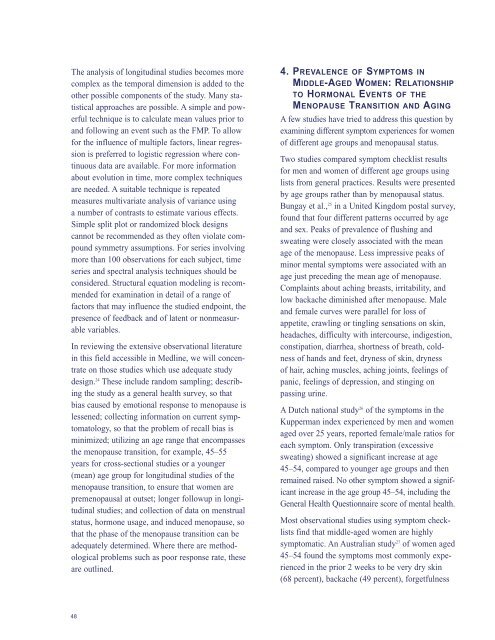WOMEN 'S HEALTH AND MENOPAUSE : - National Heart, Lung ...
WOMEN 'S HEALTH AND MENOPAUSE : - National Heart, Lung ...
WOMEN 'S HEALTH AND MENOPAUSE : - National Heart, Lung ...
Create successful ePaper yourself
Turn your PDF publications into a flip-book with our unique Google optimized e-Paper software.
The analysis of longitudinal studies becomes more<br />
complex as the temporal dimension is added to the<br />
other possible components of the study. Many statistical<br />
approaches are possible. A simple and powerful<br />
technique is to calculate mean values prior to<br />
and following an event such as the FMP. To allow<br />
for the influence of multiple factors, linear regression<br />
is preferred to logistic regression where continuous<br />
data are available. For more information<br />
about evolution in time, more complex techniques<br />
are needed. A suitable technique is repeated<br />
measures multivariate analysis of variance using<br />
a number of contrasts to estimate various effects.<br />
Simple split plot or randomized block designs<br />
cannot be recommended as they often violate compound<br />
symmetry assumptions. For series involving<br />
more than 100 observations for each subject, time<br />
series and spectral analysis techniques should be<br />
considered. Structural equation modeling is recommended<br />
for examination in detail of a range of<br />
factors that may influence the studied endpoint, the<br />
presence of feedback and of latent or nonmeasurable<br />
variables.<br />
In reviewing the extensive observational literature<br />
in this field accessible in Medline, we will concentrate<br />
on those studies which use adequate study<br />
design. 24 These include random sampling; describing<br />
the study as a general health survey, so that<br />
bias caused by emotional response to menopause is<br />
lessened; collecting information on current symptomatology,<br />
so that the problem of recall bias is<br />
minimized; utilizing an age range that encompasses<br />
the menopause transition, for example, 45–55<br />
years for cross-sectional studies or a younger<br />
(mean) age group for longitudinal studies of the<br />
menopause transition, to ensure that women are<br />
premenopausal at outset; longer followup in longitudinal<br />
studies; and collection of data on menstrual<br />
status, hormone usage, and induced menopause, so<br />
that the phase of the menopause transition can be<br />
adequately determined. Where there are methodological<br />
problems such as poor response rate, these<br />
are outlined.<br />
48<br />
4. PREVALENCE OF SYMPTOMS IN<br />
MIDDLE-AGED <strong>WOMEN</strong>: RELATIONSHIP<br />
TO HORMONAL EVENTS OF THE<br />
<strong>MENOPAUSE</strong> TRANSITION <strong>AND</strong> AGING<br />
A few studies have tried to address this question by<br />
examining different symptom experiences for women<br />
of different age groups and menopausal status.<br />
Two studies compared symptom checklist results<br />
for men and women of different age groups using<br />
lists from general practices. Results were presented<br />
by age groups rather than by menopausal status.<br />
Bungay et al., 25 in a United Kingdom postal survey,<br />
found that four different patterns occurred by age<br />
and sex. Peaks of prevalence of flushing and<br />
sweating were closely associated with the mean<br />
age of the menopause. Less impressive peaks of<br />
minor mental symptoms were associated with an<br />
age just preceding the mean age of menopause.<br />
Complaints about aching breasts, irritability, and<br />
low backache diminished after menopause. Male<br />
and female curves were parallel for loss of<br />
appetite, crawling or tingling sensations on skin,<br />
headaches, difficulty with intercourse, indigestion,<br />
constipation, diarrhea, shortness of breath, coldness<br />
of hands and feet, dryness of skin, dryness<br />
of hair, aching muscles, aching joints, feelings of<br />
panic, feelings of depression, and stinging on<br />
passing urine.<br />
A Dutch national study 26 of the symptoms in the<br />
Kupperman index experienced by men and women<br />
aged over 25 years, reported female/male ratios for<br />
each symptom. Only transpiration (excessive<br />
sweating) showed a significant increase at age<br />
45–54, compared to younger age groups and then<br />
remained raised. No other symptom showed a significant<br />
increase in the age group 45–54, including the<br />
General Health Questionnaire score of mental health.<br />
Most observational studies using symptom checklists<br />
find that middle-aged women are highly<br />
symptomatic. An Australian study 27 of women aged<br />
45–54 found the symptoms most commonly experienced<br />
in the prior 2 weeks to be very dry skin<br />
(68 percent), backache (49 percent), forgetfulness
















